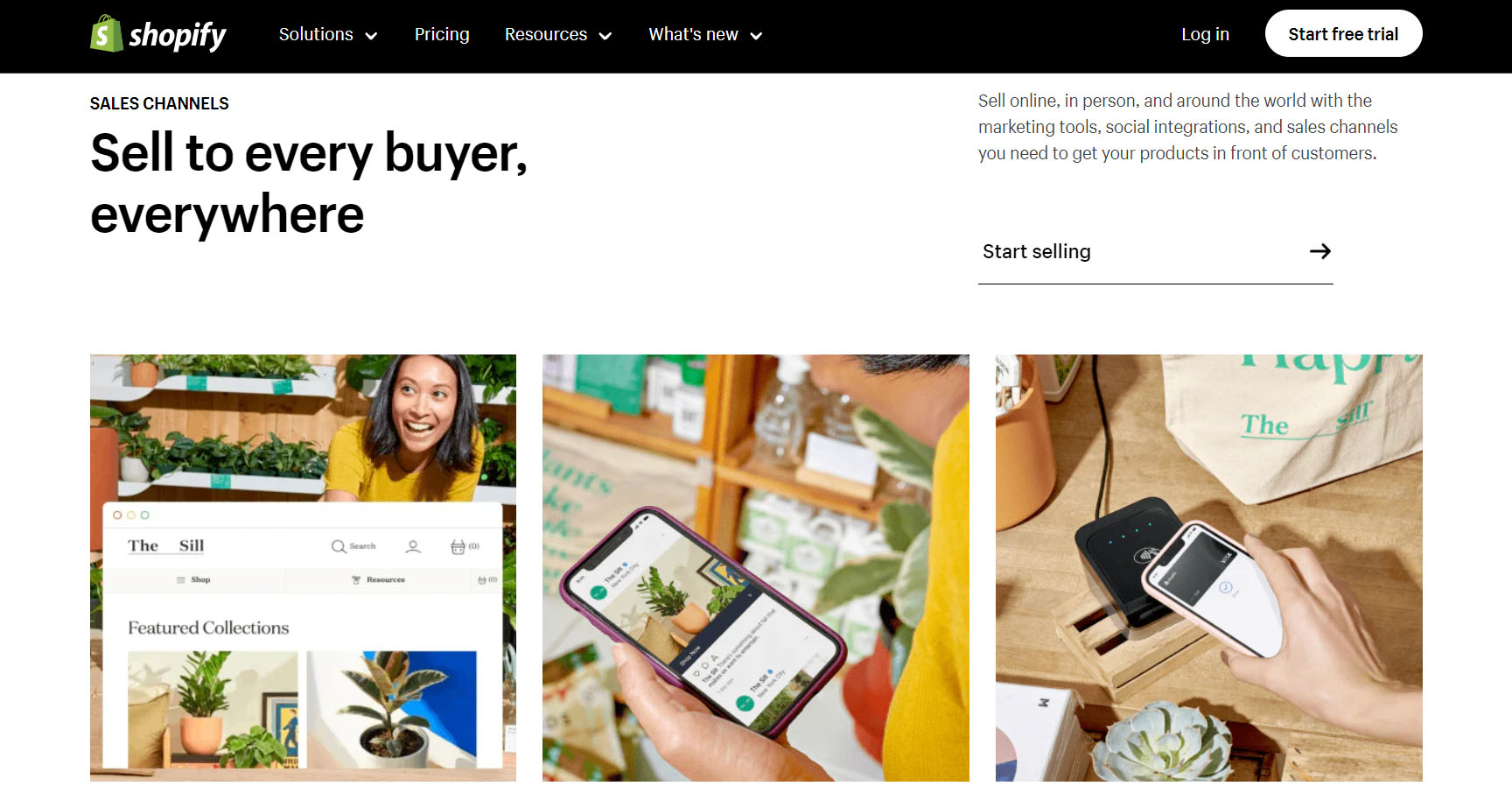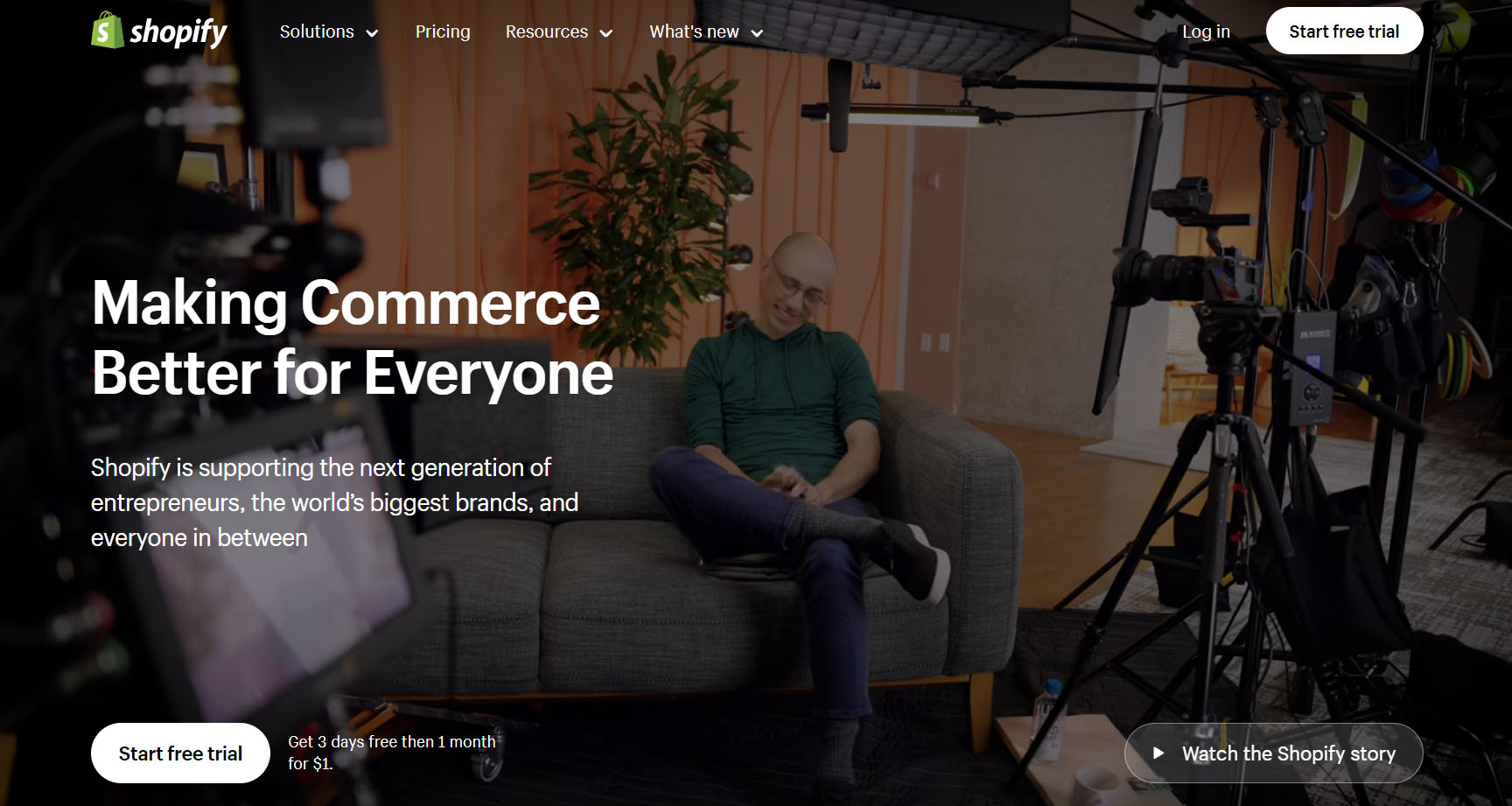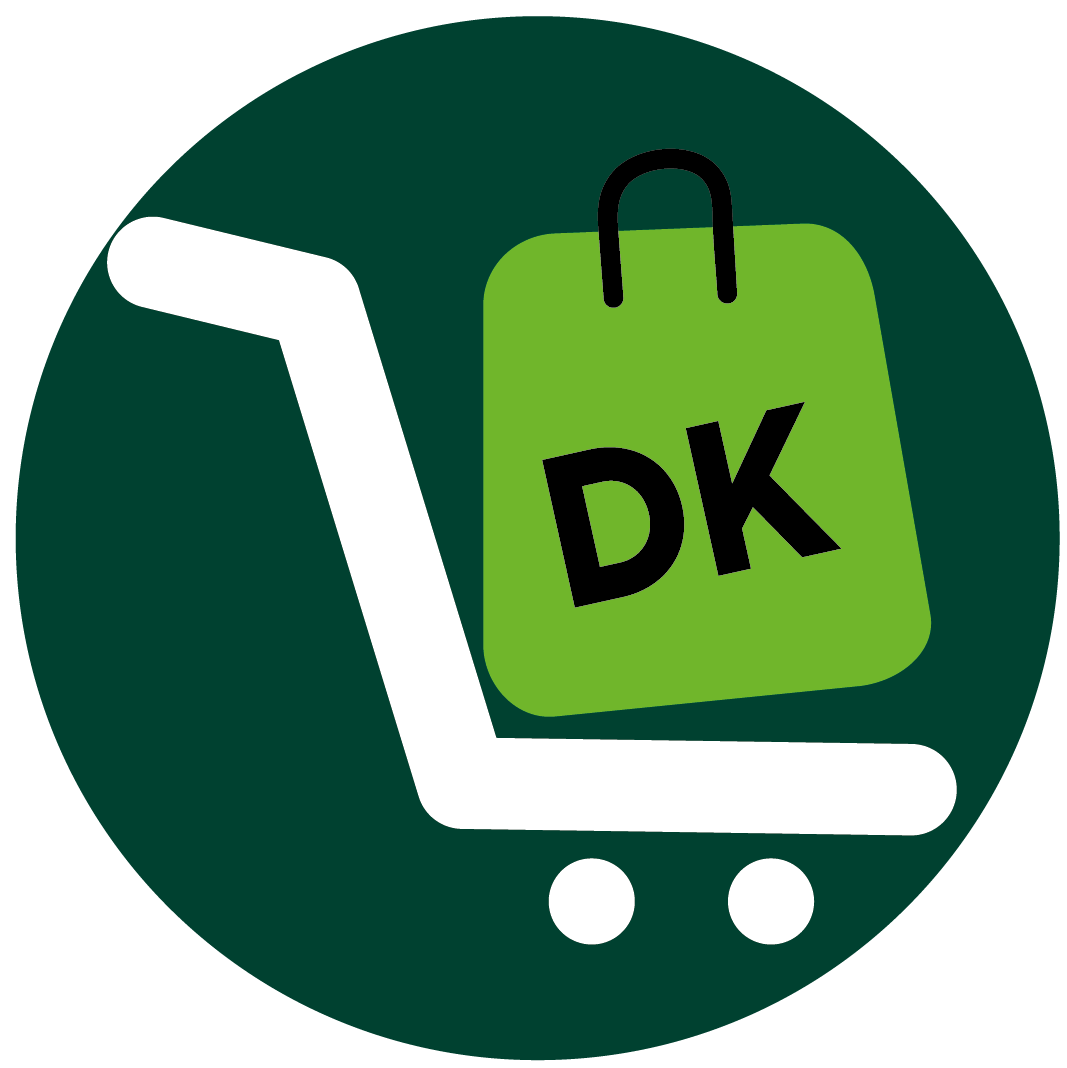Our Verdict

After extensively reviewing and comparing Shopify and Webflow side-by-side, the verdict concludes that Shopify is the best ecommerce platform for most online businesses like yours.
Shopify outshines Webflow thanks to its superior ecommerce features, larger app marketplace, easier site migration, better support options, and more affordable pricing overall.
However, Webflow does beat Shopify in certain areas like design flexibility, creative control, and not relying as heavily on apps. Ultimately though, Shopify’s specialization in ecommerce gives you the advantage for running your online store.
Below, you’ll find details about the strengths and weaknesses of both platforms to help you decide which solution may be a better fit for your specific needs.
Why Choose Shopify
There are several compelling reasons why Shopify stands out as the superior ecommerce platform:
Purpose-built for ecommerce, Shopify is engineered from the ground up to power online stores, unlike Webflow, which is primarily a website builder. This gives Shopify a decisive edge in ecommerce functionality.
With a huge app marketplace boasting over 6,000 apps, Shopify provides stores with much more flexibility to enhance and extend their capabilities as they grow.
Shopify can easily scale to support your store with over $1 million in annual sales, making it suitable for you as a high-volume merchant due to its infrastructure and enterprise-level features.
For support, Shopify users have access to phone, email, live chat, and an extensive help center, ensuring reliable assistance whenever issues arise.
When it comes to migration, Shopify makes the process simpler with import tools or by utilizing one of their Experts, unlike Webflow, which lacks native migration options.
Overall, Shopify excels in the core areas needed to operate a profitable ecommerce business. From robust analytics to smooth checkout and Fulfilled by Amazon integration, Shopify simply offers more built-in ecommerce functionality than Webflow.
Who Shopify is Right For
Shopify is an excellent choice for these types of online stores that:
- Benefits from Shopify’s extensive built-in features, powerful reporting, and high sales capacity, making it suitable for larger existing ecommerce stores.
- Aims to sell across multiple channels find Shopify seamless in its integration with sales channels like social media, brick-and-mortar retail, and marketplaces.
- Finds the user-friendly editor and guided onboarding helpful in easily setting up their first online store.
- Needs advanced fulfillment and appreciates Shopify’s top-notch shipping management and integration with fulfillment networks like Amazon FBA.
- Appreciates Shopify’s high sales thresholds and ability to handle enterprise-level order volumes, providing room for growth.
With its unmatched ecosystem of apps and integrations, Shopify readily adapts to accommodate almost any type of online retail business.
Who Shopify Isn’t Right For
While Shopify covers a wide range of ecommerce businesses, a few cases where it may not be the best fit:
- Consider exploring alternatives to Shopify if the monthly fees prove too expensive for your small shop. Free web hosting or open-source options like WooCommerce could be more suitable.
- Evaluate solutions like Lightspeed if you require centralized in-store POS capabilities beyond the mobile Shopify POS app.
- Explore Webflow’s robust design features if you seek complete control and flexibility in creating sites for your clients over Shopify’s constraints.
In essence, while Shopify caters to the needs of a wide range of ecommerce businesses, it’s important to consider these scenarios where other platforms may better align with your specific requirements.
>>> MORE : FedEx Fulfillment Review
Why Choose Webflow
However, Webflow still stands out in a few areas where you might find it appealing. With Webflow, you’ll enjoy greater design flexibility, allowing you to exercise more creative control and customize your website to your heart’s content. Unlike Shopify, Webflow handles core site functionality natively, reducing reliance on third-party apps and providing a more integrated experience for you. Additionally, if you’re on a tight budget, Webflow might be the better option as it offers free hosting and doesn’t impose forced transaction fees, making it more affordable for smaller stores like yours.
Furthermore, Webflow goes beyond ecommerce by providing full content management system capabilities. This means that if you want a website that’s not just about selling products but also includes elements like a blog or portal, Webflow offers the flexibility you need. So, if you value design originality and customization over out-of-the-box ecommerce features, Webflow holds clear advantages over more rigid templated solutions like Shopify.
Who Webflow is Right For
Consider Webflow if you:
- Need full CMS capabilities and endless visual customization options make Webflow a top choice for web design agencies.
- Own a low-volume stores can take advantage of Webflow’s free hosting and avoid Shopify fees eating into already narrow margins.
- Use content from blogs, magazines, and reviews. Sites needing some basic store capability in addition to content benefits from Webflow’s blended CMS/ecommerce model.
- Value complete creative control and flexing visual design skills have more freedom with Webflow versus rigid templated systems.
Who Webflow Isn’t Right For
Despite strengths in design and content, Webflow lacks in key areas that limit its ecommerce suitability for because you may or if you:
- Outgrow Webflow’s simple ecommerce feature set and lower sales limits, larger established ecommerce brands need Shopify’s scalability.
- Handle thousands of orders daily. Webflow’s infrastructure can’t match Shopify for stability and speed.
- Encounter limitations with Webflow, due to needing extensive product listings, requires unlimited listings to thrive.
- Require omnichannel sales, businesses find Webflow falls well short of Shopify. Webflow lacks the seamless integration of in-store retail, marketplaces, social commerce, and POS that Shopify offers.
Shopify vs Webflow: Main Differences
Shopify |
Webflow |
|
| Ideal For |
All types of ecommerce businesses |
Creative agencies and design-focused online shops |
| Pricing |
$29 – $299/month plans (Potential add-on costs from apps + fees |
Free – $74/month plans (No add-on fees) |
| Integrations |
6,000+ apps (Omnichannel selling features) |
400+ apps (Limited omnichannel support) |
| Standout Features |
Robust ecommerce functionality Enterprise-level scalability + security Omnichannel selling support |
100% custom site design CMS + blogging Free hosting |
>>> PRO TIPS : ShipBob vs Amazon FBA
Shopify vs Webflow: Standout Features
Enabling greater creative freedom and design flexibility, Webflow beats Shopify regarding better empowering users to achieve unique brand experiences.
- Outlines the Ecommerce Feature Set
Shopify offers a vastly larger set of built-in ecommerce features for managing inventory, shipping, reporting, and sales channels.
Webflow provides adequate but simpler ecommerce functionality better suited for lower-volume stores. Complex inventory and omnichannel selling requires apps.
- Enhances Functionality
Shopify provides access to over 6,000 apps to enhance functionality – from reviews to accounting.
Webflow connects with 400+ apps but relies less on add-ons. However, larger stores may still need additional integrations.
- Grants Designers More Control
Webflow enables much more creative design freedom thanks to its advanced editor and lack of strict templates.
Shopify stores must choose from a set of templates and have fewer options for visually customizing to achieve brand uniqueness.
- Facilitates Seamless Transitions
Shopify offers 24/7 live chat, phone, email, and social support alongside an enormous help center.
Webflow provides email and phone assistance but also has an extensive user forum and tutorials in its Webflow University.
- Simplifies the Process
Shopify makes switching existing stores easier by providing import tools or experts to assist with data transfer.
Webflow lacks native store migration options. Users must export product data as CSV files and manually recreate their store design.
Shopify vs Webflow: How to Create a Shopify Account

To create your Shopify account, simply visit the Shopify website and click the “Get Started” button. Enter your email address, password, and a unique store name, followed by providing business and personal information. After this, Shopify will redirect you to the admin panel to start setting up your store.
Customize your store by selecting a theme from Shopify’s Themes store, offering both free and premium options. Free themes allow adjustments to fonts, colors, and logo, while premium themes offer deeper customization options, including CSS and HTML coding. You can also seek assistance from Shopify Experts if you’re not familiar with coding.
Next, add product listings by going to the Products tab and clicking “Add Product.” Your product listings should have clear titles, descriptive descriptions, high-resolution photos, and appropriate pricing.
Activate a payment processor to accept payments, either using Shopify’s processor or a third-party system like Stripe.
Choose your domain name to personalize your store’s web address. You can either connect to an existing domain, buy a new one, or transfer an existing domain. Once your domain is set up, you’re ready to launch your store and officially start your online business.
Shopify vs Webflow: How to Sign up for Webflow

- Go to webflow.com and click on “Get Started” in the top right corner.
- Enter your email address and choose a password
- Select whether you want a free account or paid account.
- Add your first and last name.
- Choose your account type – either personal or business, If business, enter your company name.
- Click the “Get Started” button.
- Check your email inbox for a confirmation email from Webflow and click the verification link. After verifying, you will be directed to log into your new Webflow account dashboard.
- Explore the account settings, template library, and hosting options before starting your first Webflow project.
Shopify vs Webflow: Pros and Cons
With vastly more built-in ecommerce functionality, enterprise scalability, and omnichannel commerce support, Shopify emerges superior to Webflow for running complex online retail operations.
Shopify

- Pros
- Designs specifically for ecommerce functionality
- Offers robust features for store management and selling across various channels
- Hosts some of the highest-traffic online stores globally
- Expands capabilities greatly with an extensive App Store
- Reaches high sales capacity, extending into enterprise volumes
- Complies with PCI standards and offers a range of security features
- Allows highly customizable despite using templates
- Provides excellent 24/7 customer support options
- Cons
- Accumulates extra costs from add-ons and transaction fees
- Offers limited design customization compared to Webflow
- Relies on apps, resulting in less functionality out-of-the-box and potential dependence
- Requires the use of Shopify Payments to avoid transaction fees
- Lacks a built-in CMS and blogging functionality
Webflow

- Pros
- Provides complete design flexibility and control
- Eliminates template restrictions or a generic feel
- Offers CMS and blogging features
- Reduces app reliance with built-in features
- Provides a free hosting option
- Offers very affordable starter plans
- Boasts an excellent active community and tutorials
- Allows developers to code customizations
- Cons
- Presents a steep learning curve due to the overly complex editor
- Offers a limited ecommerce feature set
- Lacks a native store migration option yet
- Provides a small number of built-in integrations
- Imposes low sales limits unless on expensive plans
- Lacks support POS or omni channel selling
- Feels overwhelming for ecommerce beginners
Shopify vs Webflow: Customer Reviews
While both platforms demonstrate strong customer satisfaction, Shopify edges out Webflow by earning higher ratings across more review sites like Forbes and Capterra.
Customer sentiment indicates positive reception for both Shopify and Webflow across various rating platforms:
Shopify earns a commendable 4.5 rating from ForbesADVISORS and a solid 4.6 from Capterra.
Webflow, on the other hand, garners a favorable 4.6 rating from Capterra, a respectable 4.4 from G2, and a slightly lower 3.7 from ForbesADVISOR.
Shopify and Webflow: Competitors
If you’re looking into alternative ecommerce solutions beyond Shopify and Webflow, below are the top competitors in each space:
- BigCommerce: BigCommerce offers flexible plans starting from $29.95/month and boasts more built-in features compared to Shopify. It’s an ideal choice for established mid-market brands.
- Wix eCommerce: Wix eCommerce operates on a freemium model with plans starting at $17/month. While it excels in simplicity, it’s not as robust as Shopify.
- Squarespace Commerce: Squarespace Commerce provides stunning designer templates and is popular among small creative shops. However, its revenue share model can impact margins.
- WooCommerce/WordPress: WooCommerce/WordPress, being open-source, allows for 100% customization using WordPress plugins. While basic out of the box, it offers extreme flexibility for developers.
- Wix/Squarespace: Wix and Squarespace are popular website builders targeting design-driven entrepreneurs, although they require more clicks compared to Webflow’s direct editing.
- Bubble: Bubble is a code-free web app builder gaining traction with its visual workflow-based editor, appealing to non-developers.
- WordPress+WooCommerce: WordPress+WooCommerce is fully customizable using CMS plugins but demands developer involvement and significant hosting considerations.
Pro Tips

If you’re trying to decide between Shopify and Webflow, keep these tips in mind:
- Prioritize your “must-have” feature: Compile a list of the critical store functionality and components you need to run your business successfully online. Let those guide your platform decision.
- Understand cost considerations: Map out potential add-on expenses so no hidden surprise costs. Calculate total annual costs for essential apps, domains, shipping margins, and transaction fees.
- Compare design output: Critically evaluate if the visual flexibility in Webflow is worth the ecommerce feature tradeoffs against the polish and selection of Shopify templates satisfying your brand style.
- Get clarification answering questions: Don’t assume functionality limitations based on documentation. Reach out to customer support teams directly via live chat or phone requesting platform experts address your specific concerns.
Recap
This article thoroughly compares Shopify and Webflow as ecommerce platforms, highlighting Shopify’s superiority for most online businesses due to its comprehensive features, app marketplace, scalability, and support.
While Webflow excels in design flexibility and affordability, Shopify’s specialization in ecommerce makes it the preferred choice. The comparison covers various aspects, including account setup, store customization, product listing, payment processing, domain selection, and customer reviews.
Additionally, alternative ecommerce solutions like BigCommerce, Wix eCommerce, Squarespace Commerce, WooCommerce/WordPress, and Bubble are briefly discussed. The article concludes with pro tips for decision-making and emphasizes the importance of aligning platform features with specific business needs and design preferences.
















